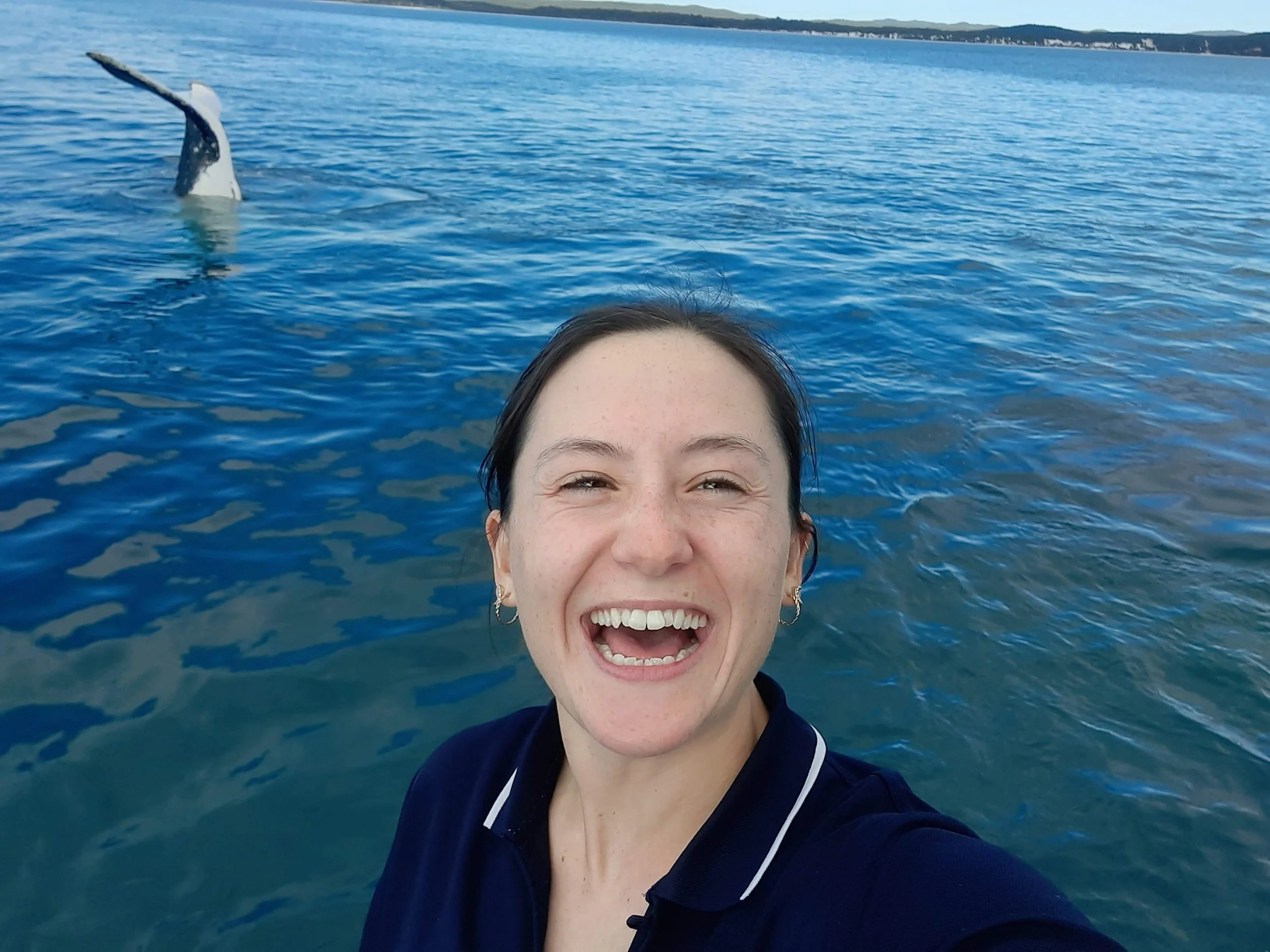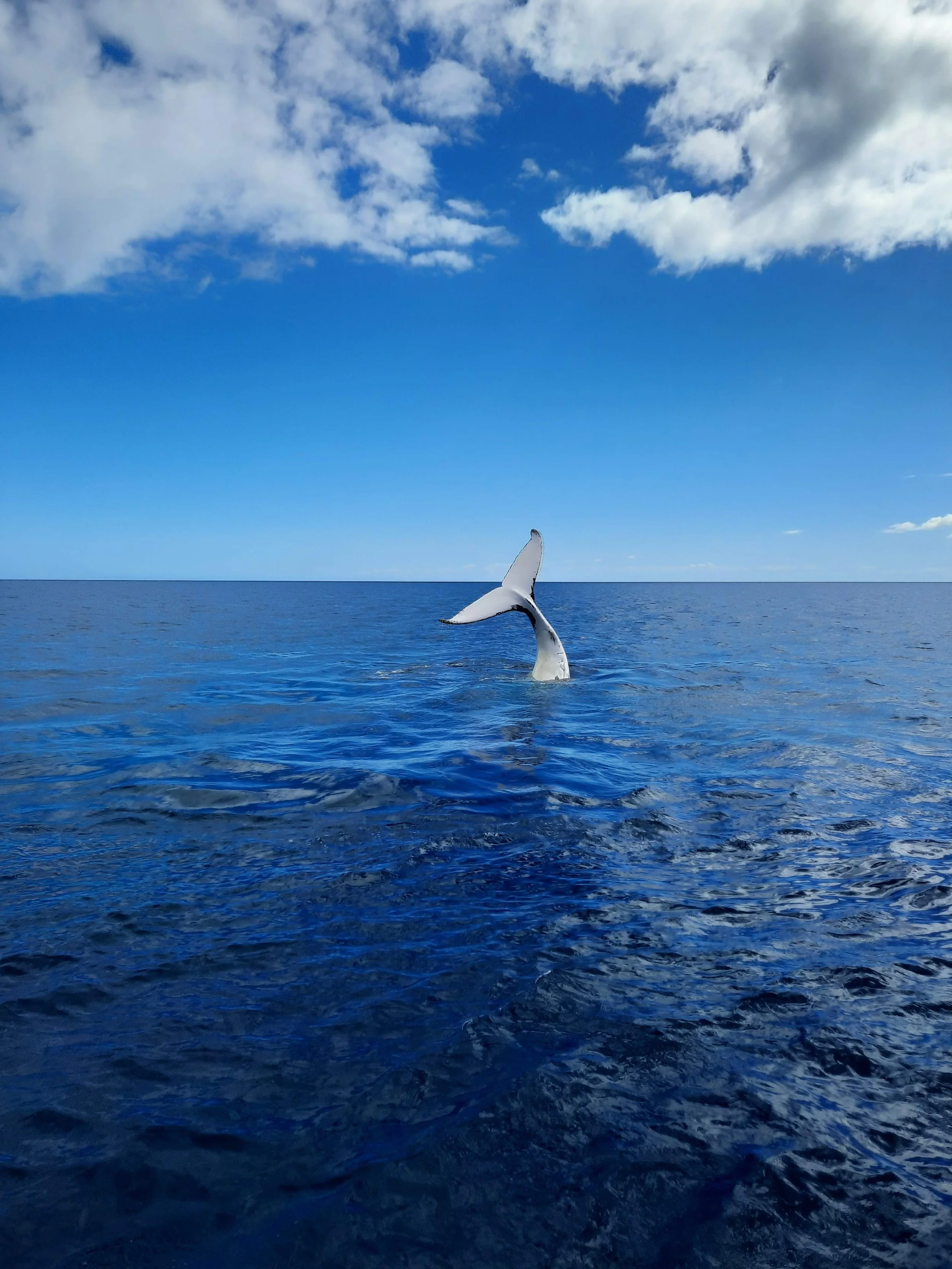#90 Humpback Whale by Leah Young
Meet Leah Young, conservation project officer at Humber Nature Partnership!
Leah is a marine biologist, currently working in marine conservation at Humber Nature Partnership. After studying Marine Biology at Plymouth University, she moved to Australia in 2020 to pursue a career in cetacean research. Leah worked as a cetacean researcher, marine naturalist and guide for 3 years in Queensland. She worked on several different projects: assessing the hearing range of Humpback Whales with University of Queensland. Understanding how the body condition of Humpback Whales changes during migration with Pacific Whale Foundation and carrying out line transect surveys of dolphin species to understand their ecology with Flinders University. She also worked in the tourism sector, doing education and outreach on Humpback Whales during the migration season. She returned to the UK in 2024, from the clear waters of sunny Queensland to the slightly murkier waters of the Humber Estuary. She is now working on a variety of projects, and has been enjoying getting stuck into stakeholder engagement, partnership working and using environmental legislation. But she has managed to slip one whale-related project in – creating a strandings protocol for marine mammals around the Humber.
Leah’s chosen species is the Humpback Whale Megaptera novaeangliae. Humpbacks are found globally, with multiple distinct populations around the world. Most populations migrate and they have one of the longest migrations in the animal kingdom, spanning thousands of kilometres. They travel from their polar feeding grounds, where they consume massive amounts of Krill and small schooling species of fish, to their tropical breeding grounds.
Leah got involved with studying Humpback Whales in 2021 as cetaceans are such a charismatic species! They are incredible to watch and study and never get boring. She’s also been lucky enough to work with Indo-Pacific Bottlenose, Snubfin, Common Bottlenose and Australian Humpback Dolphins. Understanding more about marine mammal behaviour, ecology and migration is essential so we can better protect them and their diverse habitats, from the poles to the tropics. One of Leah’s most memorable encounters was of a female Humpback Whale who brought her calf up to the boat in 2023 and ‘mugged’ the vessel - photo included! The mums tend to be quite protective of their calves and so every encounter with a curious mum and calf is extra special.
The common name Humpback comes from the hump in front of their dorsal fin. Their scientific name is just as descriptive. Megaptera means ‘big-winged’ and Novaeangliae means ‘New Englander’, which is where they were first formally described. Humpback Whales can reach around 15m in length, and their massive pectoral fins are around a 3rd of that, so they can measure in at an impressive 5m! Adult Humpback Whales weigh around 40 tonnes, and to reach this size, females will feed their calves up to 300 litres of milk per day for their first year of life.
Humpbacks are arguably one of the most enjoyable whale species to watch, as they can demonstrate a range of behaviours, from breaches and head lunges to pec slaps and spy-hops. These behaviours are believed to have a range of functions, including communication and parasite removal. Humpbacks are particularly incredible to watch in locations like Hervey Bay, Queensland. This shallow bay is a resting ground for the East Coast Humpback Whales on their migration. The whales tend to linger for a few days or weeks, making it more likely to see their wide range of behaviours and acrobatic displays. They can also be spotted at sea from their bushy blow, and this is what we are likely to spot around the UK, including around the Yorkshire coastline! You might also be lucky enough to see breaching behaviour, or a whale surfacing to feed.
Whales have long fascinated us, and one of the earliest written stories is of St Brendan and the whale. The story recounts the mythical voyage of St Brendan, Patron Saint of Whales, where St Brendan and his fellow sailors made camp on a treeless island. The island began to move, and judging from the description of throat grooves, it was the back of a baleen whale. It has also been suggested that some stories of sea serpents may even have, in reality, been sightings of baleen whales like Fin Whales skim-feeding on Krill along the sea surface.
Humpback Whales – like many whale species – were decimated during the industrial whaling period. Right Whales were the first targeted species. They were slow-moving and easy to catch, hence them being called the ‘right’ whales to catch. However, as these populations steadily declined, other large baleen whales including Humpbacks were targeted. Yorkshire itself has a long history of whaling, particularly out of Hull. It was a dangerous but profitable business, as many items could be produced from their blubber and baleen.
Humpback populations declined globally, but many populations have rebounded following the International Whaling Commission’s global moratorium on whaling in 1982. This initiative demonstrated just how successful radical conservation measures can be. Leah’s favourite example is that of the East Coast of Australia population. Researchers estimated that there were only a couple hundred individual Humpback Whales left in the East Coast. But following their protection, their population has rebounded, and they are now estimated to be back to pre-whaling levels of near 40,000 individuals. This has led to Humpbacks now being classified as ‘Least Concern’ on the IUCN Red List. This demonstrates the amazing capacity that wildlife has to recover from anthropogenic pressures, if given time and proper protection.
Humpback Whales are not a resident species around Yorkshire, but the number of sightings in our area - and in fact around the UK – have been increasing. Scientists suggest this could be due to a general increase in number post-whaling, males having to explore new feeding grounds or migration routes, or climate change affecting prey distribution and breeding ground locations. Most years there are sightings of this fantastic species along the Yorkshire coast, like these sightings from 2024. They are most likely to be spotted in the UK in summer months, between July and September. Look out for a large, heart-shaped bushy blow, ideally from a high vantage point in calm, clear weather.
Thankfully, our modern appreciation of whales now stems from whale watching rather than hunting. Although whaling is no longer a key threat for whales, there are other threats, such as climate change, fishing gear entanglement, busy shipping lanes and tourism pressures to consider. One simple thing we can do when watching humpback whales and other marine mammals, is to follow best practice and watch them from at least 100m.
Recording and monitoring
There are many global initiatives for recording and monitoring marine mammals including Humpback Whales around our coasts. Happywhale is a program which collects both scientific research and citizen science data. It has been an incredible tool for better understanding Humpback Whale migrations, with some whales unexpectedly crossing between different populations that were once considered completely separate.
Humpback Whales are identified using photo identification (Photo ID) from the underside of their tail. Their tails have a distinct shape, unique colouration and markings on them, which can include scarring. These Photo ID images can be submitted to Happywhale, where it will scan the database to check for any matches. This allows the individual whales to be catalogued. If they are a new whale, they’ll be added to the system, or existing whales will be matched to previous records. This helps us to understand more about individual whales each time they are seen, and to learn more about the population as a whole. It’s especially useful when we can get Photo ID of newborn Humpback Whale calves, as we will then know the exact year that they were born. So, if you happen to get any good photo ID images of this species, make sure to submit them to Happywhale!
Records can also be submitted to your local LERC, Seawatch Foundation, and other marine recording schemes.
Further information and acknowledgements
NEYEDC would like to thank Leah for her time and expertise in helping to create this blog.



